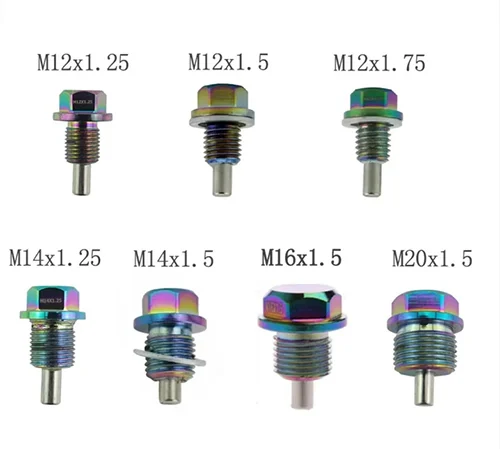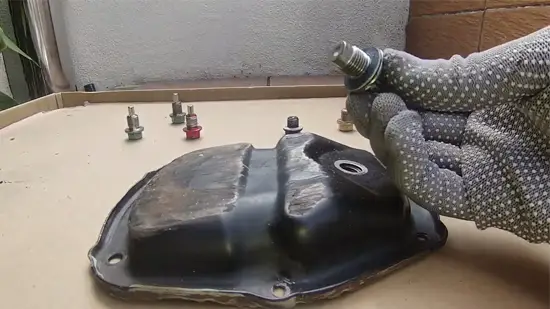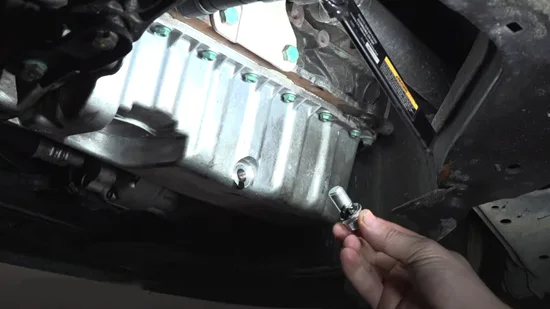Physical Address
304 North Cardinal St.
Dorchester Center, MA 02124
Physical Address
304 North Cardinal St.
Dorchester Center, MA 02124

Vehicle designs, performance capabilities, technological innovations, and even seemingly mundane components show the industry’s remarkable diversity. One such unassuming yet essential part is the oil drain plug.
While oil drain plugs may seem interchangeable at first glance, they are anything but uniform. The reality is that oil drain plugs are not universal. They come in many shapes and sizes, and understanding the reasons behind this variation is crucial for the proper maintenance and longevity of vehicles.
Here, I will discuss the reasons behind the varying sizes of oil drain plugs and explore the implications of using an oversized plug during an oil change. So, let’s dive in and uncover the secrets behind these seemingly simple yet significant components.

Regarding engine oil drain plugs, several factors contribute to their different sizes. According to my research, here are the main facts for this:
Drain plug materials vary depending on the vehicle’s engine oil type. For instance, steel is used for mineral oil-based vehicles, while aluminum or plastic is used for synthetic oil-based cars.
Steel drain plug sizes are typically larger than aluminum ones, as steel is more durable and can resist higher temperatures. Therefore, I prefer using steel oil drain plugs for their durability and strength in vehicles.
Another primary factor contributing to the oil drain plug variation is the wide range of vehicle makes, models, and years. Each vehicle is designed with unique engine configurations, resulting in different oil pan shapes and sizes.
Vehicle manufacturers prefer oil drain plug sizes and styles based on manufacturing processes, cost considerations, or performance specifications. For example, larger engines with higher oil capacities may require larger drain plugs to accommodate the increased oil flow.
Additionally, certain engine designs may require drain plug size and thread pitch to ensure a proper seal and prevent leaks.
I believe another major factor contributing to the variation in engine oil drain plug sizes in vehicles is the use of diverse thread sizes and pitches. Thread sizes refer to the diameter of the threaded portion of the drain plug, while thread pitches denote the distance between individual threads.
Different manufacturers may opt for different thread sizes and pitches based on the engine’s design, oil pan material, and desired sealing characteristics. Using diverse thread sizes and pitches ensures that the drain plug fits securely and forms a tight drain plug seal with the oil pan, preventing any oil leaks.
Oil pans are an integral part of the engine lubrication system, serving as a reservoir for the engine oil. They’re typically made of steel or aluminum and are designed to fit snugly against the engine block.
The engine layout, including factors such as the placement of the crankshaft and other internal components, determines the shape and depth of the oil pan. Additionally, oil pans may have internal baffles or trays to prevent oil sloshing and ensure proper oil pickup.
Due to the variations in oil pan design, drain plugs must be available in different sizes and styles to ensure a proper fit and seal.
When considering engine capacity, the size of engine oil drain plugs in vehicles can vary. The engine capacity refers to the total volume of all the cylinders in an engine. It’s usually measured in liters or cubic centimeters (cc).
The larger the engine capacity, the more oil it requires to lubricate and cool its components. Therefore, vehicles with larger engines typically have larger oil drain plugs to accommodate more oil. On the other hand, vehicles with smaller engines have lower oil capacities and require smaller drain plugs.
To ensure optimal performance and prevent damage, engine oil drain plugs in vehicles vary in size to withstand the heat generated by different engines. The heat resistance of an oil drain plug is crucial because excessive heat can cause the plug to warp or loosen, leading to oil leaks and potential engine damage.
High-performance or heavy-duty engines, which generate more heat due to their increased power output, require oil drain plugs specifically designed to handle greater temperature extremes. These plugs are often made from materials with higher melting points, such as stainless steel or hardened steel alloys.
Additionally, the design of the plug and oil filters may include features like cooling fins or heat-resistant coatings to dissipate heat more effectively and ensure the plug remains securely in place.
Different types of gear oil and engine oil have different properties, such as their ability to flow and lubricate engine components. The viscosity of oil refers to its thickness or resistance to flow. Thicker oils, indicated by higher viscosity ratings, are more suitable for high-temperature environments or heavy-duty applications.
On the other hand, thinner oils, with lower viscosity ratings, are better for cold weather conditions or vehicles with tight tolerances.
As per my knowledge, the size and design of the drain plug must be varied and compatible with the specific oil type and viscosity to ensure proper sealing and drainage. This ensures that the oil pan remains securely closed and prevents leaks that could lead to engine damage.
Because different vehicles have unique drainage mechanisms or systems, engine oil drain plugs vary in size and design. These drainage mechanisms are designed to efficiently remove used oil from the engine.
One common drainage mechanism is the traditional oil pan with a drain plug located at the bottom. The drain plug is usually a bolt with a specific size and thread pattern, ensuring a secure fit and preventing leaks. When changing oil, a special tool or wrench is required to remove the drain plug.
Other vehicles may have more complex drainage systems, such as a vacuum or suction system, which require a different type of drain plug.
Additionally, some vehicles may have oil drain valves instead of traditional drain plugs, allowing for easier and cleaner oil changes.
I frequently found different sizes of engine oil drain plugs in vehicles, which can be attributed to variations in vehicle weight and application.
Vehicle weight has a direct impact on the oil capacity and the rate at which it needs to be drained. Heavier vehicles, such as commercial trucks and heavy-duty vehicles, require larger drain plugs to accommodate their greater oil volume.
Additionally, the application of the vehicle also influences the size of the drain plug. For example, vehicles used for off-road or heavy-duty applications may have larger drain plugs to withstand the higher stresses and vibrations associated with these conditions.
When vehicle owners make modifications to their engines, such as increasing the engine capacity or installing additional components, it can result in the need for custom-sized oil drain plugs.
These modifications can alter the oil pan design or the location of the drain plug, requiring a different size plug to ensure proper fit and function.
Additionally, aftermarket modifications can also change the operating conditions of the engine, such as increased heat or stress, which may necessitate a larger or more robust drain plug to handle the added demands.

When working on vehicles, the most common sizes for oil drain plugs are typically 1/2-inch, 5/8-inch, 9/16-inch, 14mm, 15mm, 16mm, and 17mm. These sizes are chosen based on the specific requirements of different vehicle models and manufacturers.
As far as I know, older American cars have 1/2-inch wheels. The 5/8-inch size is often used in larger trucks and SUVs. The 9/16-inch size is commonly seen in Japanese and European vehicles.
The metric sizes, such as 14mm, 15mm, 16mm, and 17mm, are typically found in more modern vehicles from various manufacturers. Be sure to research the exact dimensions required by the vehicle manufacturer and ensure the drain plug is properly sealed.
To determine the size of your engine oil drain plug, simply measure the width of the plug at the widest part of the threads using a caliper or a ruler. This measurement will give you the diameter of the plug.
For example, if your measurement is 12mm, you’ll need to look for plugs in the size range of ‘M12 x 1.25 to M12 x 1.75.’ The ‘M12’ refers to the diameter you measured.
The next step is determining the thread pitch, which is the distance between the threads. This can be done by counting the number of threads per inch or measuring the distance between two adjacent threads.
Once you have the diameter and the thread pitch, you can find the appropriate oil drain plug for your vehicle.

During an oil change, if an oversized drain plug is used, it can cause potential issues with the sealing of the oil pan and lead to leaks or other complications.
When an oversized drain plug is inserted, it may not fit properly into the drain hole of the oil pan. This can result in an inadequate seal, allowing oil to leak out during operation.
Furthermore, the excessive size of the drain plug can put undue stress on the threads of the oil pan, potentially causing them to strip or become damaged.
In addition to leaks, using an oversized drain plug can also affect the accuracy of the oil level readings, as the oil may not drain completely from the pan.
Now you know the reason why engine oil drain plugs aren’t the same size in vehicles is due to the variety of engine designs and manufacturers. The most common sizes of engine oil drain plugs are 14mm, 15mm, and 16mm.
To determine the size of your oil drain plug, you can refer to your vehicle’s manual or consult a mechanic. If an oversized drain plug is used during an oil change, it can lead to leaks and potential engine damage.
For example, in a case study, a car owner mistakenly used a larger drain plug, resulting in oil leakage and costly repairs. Therefore, I recommend that you always use the proper size of oil drain plug in your car.